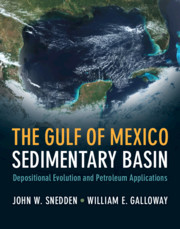Book contents
- The Gulf of Mexico Sedimentary Basin
- The Gulf of Mexico Sedimentary Basin
- Copyright page
- Dedication
- Contents
- Preface
- Abbreviations
- Part I Introduction
- Part II Mesozoic Depositional Evolution
- Chapter 2 Post-Orogenic Successor Basin-Fill and Rifting Phase
- Chapter 3 Middle Mesozoic Drift and Cooling Phase
- Chapter 4 Late Mesozoic Local Tectonic and Crustal Heating Phase
- Part III Cenozoic Depositional Evolution
- Part IV Petroleum Habitat
- Glossary
- References
- Index
Chapter 3 - Middle Mesozoic Drift and Cooling Phase
from Part II - Mesozoic Depositional Evolution
Published online by Cambridge University Press: 13 September 2019
- The Gulf of Mexico Sedimentary Basin
- The Gulf of Mexico Sedimentary Basin
- Copyright page
- Dedication
- Contents
- Preface
- Abbreviations
- Part I Introduction
- Part II Mesozoic Depositional Evolution
- Chapter 2 Post-Orogenic Successor Basin-Fill and Rifting Phase
- Chapter 3 Middle Mesozoic Drift and Cooling Phase
- Chapter 4 Late Mesozoic Local Tectonic and Crustal Heating Phase
- Part III Cenozoic Depositional Evolution
- Part IV Petroleum Habitat
- Glossary
- References
- Index
Summary
The Middle Mesozoic Drift and Cooling Phase begins with the main phase of sea floor spreading, slowly but steadily opening the Gulf of Mexico basin. Initially hypersaline conditions resulted in basin-wide deposition of an original thickness of 4 km of evaporites (halite and updip anhydrite), called the Louann Salt, which likely formed with episodic seawater influx from the Atlantic Ocean. Strontium seawater analysis suggests 170 Ma as a proxy age for the Louann Salt. The arid eolian Norphlet Formation is subsequently deposited, followed by marine carbonates, evolving from ramp microbalites (Smackover) to platform margin reef systems of the Haynesville and Cotton Valley. Rafting apart of the Smackover and Norphlet in the northeast Gulf of Mexico began in this phase, possibly associated with oceanic crustal cooling which created a dip slope to the south and west. This set up a major new petroleum province which is host to several new giant oil discoveries. Periods of reduced bottom circulation resulted in at least two phases of source rock development, in the Oxfordian and Tithonian stages, that are linked to petroleum generation for both conventional and unconventional plays.
Keywords
- Type
- Chapter
- Information
- The Gulf of Mexico Sedimentary BasinDepositional Evolution and Petroleum Applications, pp. 65 - 100Publisher: Cambridge University PressPrint publication year: 2019

